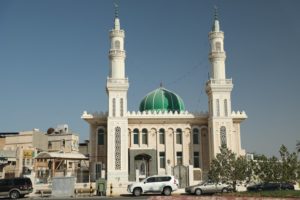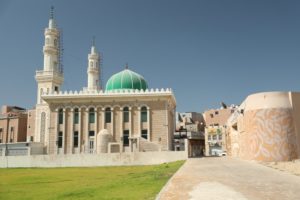The temperatures have been warm during my stay in Dammam, ranging from 108 to 112 degrees Fahrenheit during the hottest parts of the day. I’ve been wandering around the city on foot for the past several days. My experience in extreme heat in the past has paid off, alternating between consuming copious quantities of water alternating between fruity and other sweet drinks. To compound things, several days offered up a stiff breeze (and that’s putting it mildly), further increasing the chance of dehydration.
This is clearly not a pedestrian friendly city; one car even tried to have a little ‘fun’ with me, swerving across the 4-lane boulevard barreling right at me while I was standing next to the highway before swerving away at the last minute. Distances are great and everything in the city seems to be so spread out. Several boulevards have fences running down the middle of both sides of traffic and one must walk great lengths to cross to the other side despite what Google maps shows. Some intersections offer signs showing little green men indicating when it is safe to cross the road. But in a couple of such cases I discovered several more lanes with fast moving traffic not even subject to a stoplight! I almost continued walking until I discovered what was going on. It took me 10 minutes to cross one intersection.
And while Google Maps is my go-to app for getting around while traveling, in Saudi Arabia its helpfulness is somewhat limited. For example, most of the restaurants it shows as open are in fact closed and in multiple cases it showed a restaurant as being open and upon arriving, the building had been demolished or the restaurant was no longer operating or had been converted into some other business. In these cases of no longer in business restaurants, Google Maps even continued to list the level of how busy the space was at any particular time. And a number of times it offered pedestrian routes which were next to impossible to follow, i.e., tall fences blocking a pathway or even blocking access to crossing roads.
One day I walked out to what is listed as one of the top attractions in Dammam, Murjan Island. On the way I passed through numerous neighborhoods, some of the security systems in place, beeping to alert the owners that someone had walked in front of their entrance. I don’t know if the island was man-made or not, but the curved road was clearly not natural, supported by imposing large rocks. The island was deserted and like the road, surrounded by rocks. Expecting beaches, I was sorely disappointed, but I went swimming anyways, sliding into the water over the rocks fully clothed. Between the wind and the extreme heat, I was completely dry within about 10 minutes. The bathroom was another highlight of my visit to this island; it was a source of hot water which I soon soaked myself in and was also a respite from the blazing sun and heat.
While walking back I ran out of water, and just when things were looking desperado, I discovered a miraculous invention: a water cooler hooked into the city water supply in one of the neighborhoods. The water came out cold – I filled up one of the provided metal cups and dumped it over my head. Glancing at the back of the device I noticed the filter was completely filled with orange and green algae and other nasty looking gunk. I already had the Baghdad belly (similar to the Delhi belly) from my previous week in Iraq; I was on the verge of dehydration (self-diagnosed), so I took a chance and consumed copious amounts of the refreshingly cold water.
Another day I walked 90 minutes to Souk Al Hub. I left around mid-day during the peak of the heat. I stopped many times in shade including under one date palm tree where it was just me and a well-preserved dried-up still covered in fur, cat lying on the pavement. Souk Al Hub seemed to predominately be rug vendors, with employees primarily Indian. The nearby Ameer Muhammad Bin Fahd Masjid Mosque is impressive; I stopped in its bathroom joining other men sitting on tiled pedestals in front of water spigots, splashing water all over my face and clothes.
Longing for some Asian food, I spotted Bamboo Restaurant, which advertises themselves as the largest Filipino restaurant in Dammam. The food was average, but the air conditioning felt amazing.
And towards the end of my week stay, I discovered that Uber works here and I used this valuable service to explore further afield. One day I visited Tarout Island – the highlight being the old castle and old town. I wandered around the streets for several hours eventually seeking out restaurants, but none were open and the few that were, served only tea and coffee. Eventually I stumbled into a small space serving Indian food. My ‘hotness’ meter registered a 10+ on the food and I stumbled out of there gasping for air.
Unfortunately, Dammam hasn’t embraced the waters of the Persian Gulf from a beach or swimming perspective. Miles of uninterrupted coastline is lined with rock walls, intended to keep the coast from eroding while simultaneously preventing any sort of beach activities.













So many discoveries for your first time in Saudi Arabia, with so many eye-opening experiences!
Teh. Yes! It wasn’t the easiest city to get around, next time I’ll explore further inland.
Saudi Arabia offers a captivating blend of ancient traditions and modern wonders for adventurous souls. Explore the vast desert dunes of the Rub’ al Khali, dive into the Red Sea’s vibrant coral reefs, or wander through historic cities like Riyadh and Jeddah. The kingdom welcomes intrepid travelers with open arms.
Love to read your blog.
Min. More great suggestions:)
Hunza Valley, Pakistan: A Full Guide To Pakistan’s Jewel Of The North
Nestled amidst the grandeur of the Karakoram Mountain range lies the breathtaking Hunza Valley. Often referred to as the ‘Shangri-La of Pakistan’, this destination, with its snow-capped peaks, crystalline waters, and lush orchards, is nothing short of a paradise for travellers. If you’re setting your sights on a tour to Hunza, get ready for an experience that seamlessly blends serenity with exhilaration. Let’s navigate through the gem of northern Pakistan together.
Why Visit Hunza Valley?
Hunza’s charm lies in its untouched beauty. Every horizon unveils landscapes that seem straight out of an artist’s palette. Beyond its scenic allure, Hunza is an intricate tapestry of culture and history, offering a union of nature and tradition that’s genuinely unparalleled. When planning a tour to Hunza, this valley unquestionably deserves your attention.
How to Get There
The most efficient approach to Hunza is via Gilgit, accessible by both air and road. Once in Gilgit, Hunza is but a picturesque drive away. Travelot is the premier online platform where an array of Pakistani tour operators present their curated Hunza tour packages. This makes it effortless for travelers to pick a journey that resonates with their travel aspirations.
What to Do in Hunza
• Historical Exploration: Embark on a tour to Hunza and step into its past with a visit to the Baltit and Altit Forts. These age-old structures provide not only insights into Hunza’s history but also panoramic views of the valley, making them an essential part of any Hunza tour package.
• Stroll through Karimabad: Central to many 3 days tour to Hunza packages, Karimabad is the heart of the valley. It’s a cultural hub where you can discover local crafts, relish traditional Hunza delicacies, and engage with the warm locals. Shopping for souvenirs or simply soaking in the ambiance, Karimabad promises a memorable experience.
• Mountain Gazing at Rakaposhi View Point: As part of your tour to Hunza, don’t miss the majestic sight of Rakaposhi. This snow-capped giant offers a spellbinding view, especially from the designated viewpoint, making it a photographer’s dream.
• Attabad Lake’s Serenity: A testament to nature’s unpredictability and splendor, Attabad Lake is a must-visit on any Hunza tour package. Born from a landslide in 2010, its azure waters now beckon travelers for serene boat rides set against a breathtaking mountainous backdrop.
• Hopper Glacier Hike: Those opting for an adventurous 3 days tour to Hunza should consider a hike to Hopper Glacier. The contrasting visuals of blue ice and lush green pastures promise an unforgettable trekking experience.
• Local Culinary Delights: Hunza is not just a visual treat but also a gastronomic one. Dive into its culinary landscape with traditional dishes like Hunza bread, apricot jams, and the unique apricot kernel oil tea. A must-try for food enthusiasts on a tour to Hunza.
• Cultural Engagements: Enrich your Hunza tour package by participating in local events, from traditional dances to music sessions and festivals. Experience the genuine warmth and hospitality of the Hunzai people.
With these activities, not only will you delve deeper into the soul of Hunza, but you’ll also ensure that your trip offers a holistic experience, touching every facet of this enchanting valley.
A Glimpse into a 3-Day Tour to Hunza
For those who can spare a brief hiatus, a 3 days tour to Hunza offers a condensed yet captivating insight into the valley’s magic. Begin by immersing in the cultural wonders of Karimabad and the ancient forts. Nature enthusiasts can revel in the beauty of Rakaposhi View Point and the serenity of Attabad Lake. And, of course, no visit is complete without savoring traditional Hunza delicacies and diving into the bustling local markets.
When to Visit
April to October stands out as the ideal window for a tour to Hunza. The climate is inviting, and the valley showcases its most vibrant palette. However, those yearning for a snowy spectacle will find November to February equally enchanting, albeit with a chilly embrace.
Discovering Hunza with Travelot
For wanderlust souls eager to journey into Hunza’s embrace, Travelot emerges as the ultimate ally. As Pakistan’s leading tourism marketplace, it offers a diverse array of Hunza tour packages, all showcased by top-tier Pakistani tour operators. Whether you desire a luxurious escape, an adventurous trek, or a swift 3 days tour to Hunza, Travelot promises a curated selection, ensuring your travel dreams are fully realized.
Conclusion
Hunza Valley is a radiant testament to the timeless beauty that Pakistan cradles in its northern expanses. Whether you’re an adrenaline junkie, a history aficionado, or a seeker of tranquility, Hunza beckons with an embrace that promises memories for a lifetime. Dive into Travelot, unearth your dream tour package, and let Hunza’s magic cast its spell on you.
So you have a lot of experience to do in Saudi Arabia. It sounds great. I want to explore Dammam for sure because Dammam, a vibrant Saudi city on the Arabian Gulf coast, boasts stunning beaches, rich history, and a thriving business hub.
I have never been there ,but I would love to visit Saudi Arabia! Thank you for sharing!